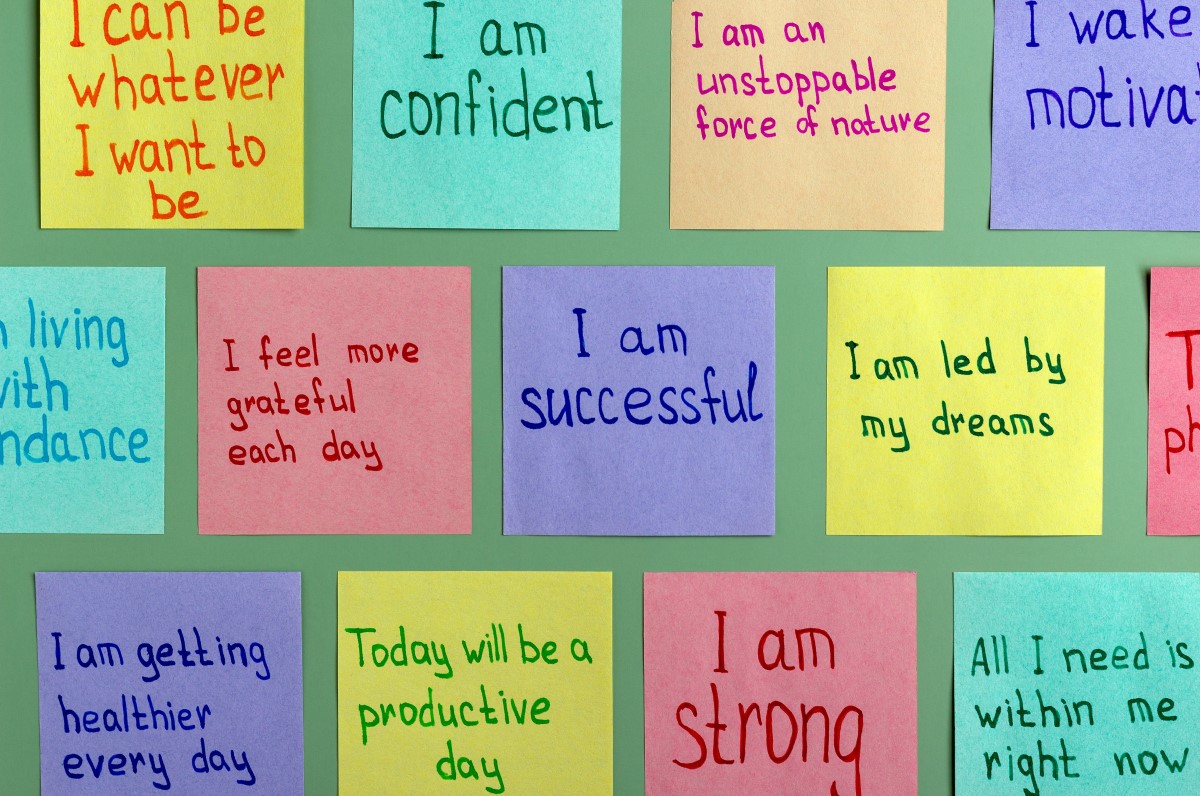Summary: I talk about the mental game of investing, particularly as it applies to crypto markets. Subscribe here and follow me to get weekly updates.

Money guru Suze Orman tells a story of taking a job as a Merrill Lynch financial advisor in the 1980s. In that male-dominated industry, complete with power suits and BMWs, she felt terrified and unqualified.
She didn’t have the right clothes, or the money to buy them, so she charged $3000 to her Macy’s credit card for a new wardrobe. She hid her 1967 Volvo station wagon on the street, out of sight, constantly feeding the meter and racking up parking tickets.
In the midst of her doubt and insecurity, she came up with a new positive thought for herself:
“I am young, powerful and successful, producing at least $10,000 a month.”
She wasn’t young (almost 30), she wasn’t powerful (more like pitiful), and she wasn’t producing anything near $10,000 a month (that’s $38,000 today, or about $450,000 per year).
But she repeated the affirmation 25 times a day — sometimes silently, sometimes screaming — looking at herself in the mirror as she repeated it.
Day in, day out, 25 times a day.
After six months of this practice, she said, things started to click. And soon she began to develop a media persona that was young, powerful, and successful, earning far more than $10,000 a month. She wrote ten consecutive New York Times bestsellers, with her hit The Suze Orman Show running on CNBC for over a decade. Today, estimates place her net worth between $25 million and $75 million.
I’ve simplified her long and winding career into a paragraph, but it’s clear that the affirmation was the accelerator.
Many other celebrities have successfully used positive affirmations to help them accelerate a winning mindset:
“I am the creator of my reality.” – Jim Carrey
“I am capable of accomplishing anything I set my mind to.” – Beyonce
“Everything is always working out for me.” – Oprah Winfrey
“I am intelligent, strong, and capable.” – Jennifer Aniston
“Success isn’t always about greatness, it’s about consistency. Consistent hard work gains success. Greatness will come.” – Dwayne Johnson
Clearly each of these celebrities had tons of talent, and a world-moving work ethic. They didn’t just lay in bed and think positive thoughts. But in each case, affirmations ignited that talent and exploded the work forward. Affirmations were the accelerator.

Affirmations are Accelerators
Some believe that affirmations help “manifest” your dreams, but I think about it less magically and more logically: affirmations prime your mind for success.
Anything we repeat to ourselves over a long period of time, good or bad, becomes a part of our belief system.
Mental repetition carves new “grooves” into our brain, like digging rows in a garden to plant new seeds. Those seeds — the positive thoughts we want to cultivate – will eventually take root and bear fruit.
Affirmations Help Us Overcome Obstacles
You’ve heard the saying that you “make your own luck,” but researchers are showing that’s literally the case. Dr. Christian Busch has studied those with a “serendipity mindset,” which simply means you find meaning in life’s everyday twists and turns.
Busch talks about “connecting the dots” between seemingly random events: that chance introduction to a recruiter is something you take seriously, which leads to a great career opportunity. Or losing money on an investment causes you to rework your investing strategy, which leads to far greater gains down the road.
Affirmations prime this kind of thinking. They help you “connect the dots” between your setbacks and the goals you’re trying to achieve. They make you resilient in the face of hardship, as with Oprah’s affirmation. A serendipity mindset means seeing obstacles as opportunities.
Affirmations Help Us Spot New Opportunities
Affirmations also give you X-ray vision for new opportunities. We are swimming in opportunities every day, but it takes a special kind of outlook to see them. Affirmations help you “connect the dots” between seemingly random ideas – for example, noticing that parking is easier to find could lead to an investment in Zoom (ZM) – and that, too, is a serendipity mindset.
By helping us to both overcome obstacles and observe opportunities, affirmations are accelerators to our goals and dreams.
There’s also science behind it: a 2005 study shows that positive self-talk can reduce stress. And a skeptical 2009 study that questioned the validity of affirmations nevertheless found that people with higher self-esteem used positive affirmations more frequently: the more positive the self-esteem, the more helpful they found affirmations, suggesting a positive feedback loop.
Perhaps the most important finding from this study was that 97% of respondents already used regular affirmations, leading the authors to conclude, “The results confirm that positive self-statements are used commonly (by Westerners) and are widely believed to be effective.”
So, if you’re not already using affirmations, why not? And if you are, why not more frequently?

Top 5 Affirmation Techniques
While positive self-talk has been encouraged for millennia by spiritual traditions like Buddhism, Yoga, and Christianity, the modern form probably originated with the Stoics, around 300 BCE. The Roman Emperor Marcus Aurelius dropped this knowledge bomb which bloggers are still pondering today:
“The things you think about determine the quality of your mind. Your soul takes on the color of your thoughts.”
Then he recommended a daily discipline of affirmations:
“Say to yourself in the early morning: I shall meet today ungrateful, violent, treacherous, envious, uncharitable men. All of these things have come upon them through ignorance of real good and ill.”
The French psychologist Émile Coué was the first to popularize affirmations for a global audience, at the beginning of the 19th century. He became famous for this phrase, which is still used today by motivational and self-help gurus:
“Every day, in every way, I am getting better and better.”
Authors like Norman Vincent Peale (The Power of Positive Thinking), Napoleon Hill (Think and Grow Rich), Mary Baker Eddy (founder of Christian Science), Louise Hay (You Can Heal Your Life), and Shakti Gawain (Creative Visualization) took the ball and ran with it through the 20th century, writing extensively about the power of positive thinking, with affirmations playing a central role.
Gawain’s bestseller contains a library of affirmations from which you can pick and choose:
“I love doing my work, and I am richly rewarded, creatively and financially.”
“I communicate clearly and effectively.”
“I now have enough time, money, energy, and wisdom to accomplish all my desires.”
“I am always in the right place at the right time, successfully engaged in the right activities.”
“This is an abundant world, and there’s plenty for all of us.”
Many modern self-help speakers talk about the power of affirmations, including Jack Canfield, Wayne Dyer, and Tony Robbins. They vary in their technique, but here are the 5 major flavors:
Affirmations: This is the basic discipline, repeated daily (or more often), usually first thing in the morning or just before bed. You can use a habit tracker app to help you stick to it every day, and challenge yourself to a six-month “streak.”
Written affirmations: You can also write down the affirmation, anywhere from 1 to 25 times a day. I’m a big fan of this method, as the muscle movement and mental focus make it a more purposeful discipline than just saying it to yourself.
Visualizations: Some authors add in an imagination component, explaining that the more you can see yourself in the desired state (with the successful business, the healthy investment account, or the life partner), the better.
Emotions: Some recommend cultivating the feeling of achieving the goal. You feel yourself on a stage, inspiring thousands of people. You bask in the sunshine of success. You work up earth-moving desire to get there.
Vision boards: Finally, you can go artsy-craftsy and create a collage of all the things you would like to be, have, give, or do. If you’re skeptical, read the testimonials of those who have tried it and swear that it works.
These affirmation techniques can be stacked or swapped, and my suspicion is that it doesn’t really matter which ones you use. The most important thing is to do it consistently, for the long term (daily, for at least six months).
Affirmations for Investors
Most investors I talk to have no idea what they’re trying to achieve. They don’t have clear long-term goals, no dollar figures. So it’s little surprise that they never get there, because there is no “there” there.
For investors, affirmations help accelerate your goals. The discipline of doing daily affirmations is that it helps you get specific. It helps you set concrete goals on what you want to achieve, understanding those goals may evolve over time.
Here are a few more you may want to try:
“Every day I am growing more financially prosperous.”
“The more I have, the more I have to give. The more I give, the more I receive, and the happier I feel.”
“I have a net worth of $___, investing in projects and people I am passionate about.”
“I am relaxed and centered. I have plenty of time and money for everything.”
“I have a wonderful job with wonderful pay. I provide a wonderful service in a wonderful way.”
Treat affirmations like an experiment. It’s free to test them out on your own life; there’s really nothing to lose. And you may just have many incredible experiences to gain.
50,000 crypto investors get this column every Friday. Click here to subscribe and join the tribe.

